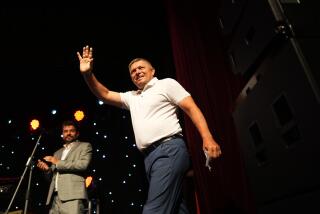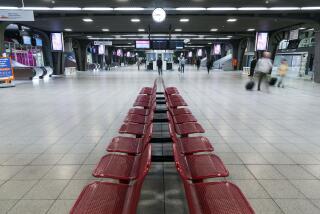Bratislava, Slovakia: A velvety visit to old city with new touches
If your destination is Bratislava, be prepared for a few questions: Is that in Eastern Europe? (No, it’s in Central Europe.)
Capital of Slovenia, right? (Uh, no.)
Where is that? (The last question courtesy of a Customs employee at LAX.)
Until recently, my schooling on all things Bratislavan occurred during a 20-minute stop on a train traveling from Prague, Czech Republic, to Budapest, Hungary, almost a decade ago. Several travelers boarded; a few disembarked. Some of them flashed passports, suggesting that we had stopped in a different country, in a major European city about which I knew … nothing.
There’s only one cure for that sort of knowledge gap.
In September, my husband, Steve, and I fly to Frankfurt, Germany, and then Vienna and then hop in a cab for the 50-minute drive to the capital of Slovakia, a relatively small country that stacks neatly atop Hungary on a map. But it doesn’t fit quite as neatly into any tourism cliché. We know where it is, but figuring out what it is takes more exploration.
We bid the driver goodbye just outside Old Town about 8 p.m., plunging into the historic core with an enthusiasm that wanes slightly after dragging our suitcases over cobblestones for the next 45 minutes. Soon we discover that our hotel, Hotel Michalska Brana, is down an alley so narrow that even the smartest of smart cars wouldn’t attempt the drive.
In the morning we are in a better frame of mind to assess the hotel and its amenities. We’ve ended up in a handsome suite with a tiny kitchen facility and a living room decorated with furniture that screams Ikea. The bedroom is similarly appointed, and both rooms have the requisite flat-screen TV. The view includes a large courtyard blessed with a smattering of brilliantly green trees and a bar and restaurant with a spectacular sound system. On this morning, the cleaning crew listens to the disembodied voice of a DJ declaring “Michael Jackson is not dead” as a segue to “Billie Jean.”
Before we depart, we fortify ourselves in the hotel’s breakfast room, which provides a robust sampling of fruit and yogurt, cheeses, meats and bread and juice and coffee. In the background, yet another flat-screen TV, this one tuned to CNN, delivers the latest on the Conrad Murray trial — another reminder of the thirst for American pop culture.
We have traveled 6,000 miles to immerse ourselves in a country that has been settled by (or ruled by) Celts, Romans, Slavic tribes, Magyars, Tartars, Turks and Habsburgs, Germans and Soviets, a land that became a country in 1993 after the so-called Velvet Divorce from the Czech Republic. We seek out dumplings and garlic soup and the ham rolled around horseradish cream. During our visit, we trek about a mile uphill to the Bratislava Castle, a several-times restored structure that looks a bit like an upside-down table whose origins date to the 15th century and is now a museum and national monument. We climb to the top of Michalska Brana (Michael’s Gate), whose Gothic foundations, according to our guidebook, were laid in the early 14th century.
We also encounter Katy Perry as pop icon, Courtney Love as muse and graffiti reminiscent of works in last year’s Art in the Streets at L.A.’s Museum of Contemporary Art. In addition to strip bars.
One night, after we attend a decent performance of “Carmen” at the Slovak National Theatre, we sit in an outdoor cafe, drinking wine and listening to a cover band in a bar playing music from the Jethro Tull album “Aqualung.” Bratislava is nothing if not a spectacular cultural mash-up.
On our first morning we stroll to get the lay of the land. The Slovak National Gallery seems like a must-do — surely its exhibits will help us better understand the city and country. We are two of only four or five visitors — and the guards look at us with suspicion — or was that annoyance? — each time we open the door to a different gallery. The permanent collections feature Gothic, religious and Slovakian art we don’t find appealing. Instead, we find ourselves drawn to an exhibition of whimsical works by Baroness Margita Czobelova, a Slovakian illustrator and painter.
Afterward, we lunch at Presburg, a cafe that seems to cater to tourists. The goulash turns out to be so perfectly spiced that I can’t contain my inner glutton and wipe slice after slice of white bread in the sauce. Steve orders the special, which starts with a mushroom soup bursting with earthy flavor followed by a not-so-astonishing chicken schnitzel.
A postprandial stroll takes us by several whimsical — and modern — statues that seem to capture the fancy of every tourist. A piece called “Cumil” (also known as “Rubberneck”) attracts the largest crowds, tourists who cannot resist the bronze man poking his head and part of his torso out of a manhole. It’s corny, but alluring, as evidenced by Steve’s many poses curled up beside the bronze.
Other statues depict Hans Christian Andersen, a photographer with a box camera and a Napoleonic army soldier sprawling on a bench. Their modern feel contrasts with the 17th, 18th and 19th century structures nearby.
The next day we hike to the Bratislava Castle, which offers postcard views of a more modern sector of the city on the other side of the Danube — with blocks of what appears to be Soviet-era housing. We pay to view the treasures, which are not jewels but coinage and pottery from the last several hundred years. Disappointing.
Afterward we wend our way down the hill, choosing a circuitous route that took us close to the walls of the Old Town and St. Martin’s Cathedral, a Gothic structure whose construction was started in the 13th century. It’s a tourist attraction, but it’s also a busy Roman Catholic church and we are told to wait until Mass is over before entering. We promise ourselves a return visit and depart.
We need another dose of culture, I think, and check out the Palffy Palace, built in the 1850s for a government official and now home to one of the city’s best-known art galleries. We are again reminded of the influence of American pop culture as we enter an exhibition devoted to the work of photographer and documentarian David LaChapelle. It starts with a video made during the preparation of a photo shoot re-creating a Pieta scene with Courtney Love, a video that shows, among other scenes, “Mary” and “Jesus” getting their hair done, and ends with the burning of the set.
Most of us are caught up in the moment, but a man sitting next to me hisses, “What are we doing here?” The man is Steve. His mood does not lift as we tour other images from the artist known for his surreal, highly sexualized work. But this gallery, unlike the national gallery, is full of visitors, most of them mesmerized, myself included.
Lunch at the nearby Minerva revives us. We order another dish that is billed as Slovakian, slovenska pachutka, beef wrapped in what seems like a thick wheat crepe with yet another remarkable sauce redolent of paprika. We cannot help but notice a table of six boisterous thirtysomething men speaking German loudly and roughhousing in a way that says: We are consumers of laddie magazines.
Their good mood is contagious. If there’s a dominant vibe in Bratislava, it’s one of congeniality and comfort — perfect for a long weekend. What’s not to like about beer, dumplings and public art that inspires smiles all day?
Weekdays, the crowds seem manageable. On Friday, however, the action picks up with gaggles of tourists. The energy level rises noticeably around 9 p.m. We decide to dine at Primi, the courtyard restaurant wrapped by our hotel building. The liquor is flowing, and the American Top 40 singles are loud. Bratislavans need to cut loose like everyone else.
We leave the restaurant around 11:30 and check out the party crowds around Old Town. Their excitement is irresistible, but eventually we return to the hotel. The festivities challenge our schedule. The revelers seem to particularly enjoy Katy Perry’s “Last Friday Night”: “Yeah we danced on tabletops / And we took too many shots / Think we kissed but I forgot.”
By the time they have the opportunity to sing along to Katy it is no longer Friday night, but Saturday — about 3:30 a.m. Finally, Old Town goes to sleep and so do we.
More to Read
Sign up for The Wild
We’ll help you find the best places to hike, bike and run, as well as the perfect silent spots for meditation and yoga.
You may occasionally receive promotional content from the Los Angeles Times.







